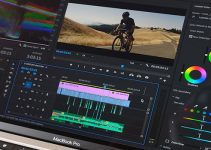It’s getting more and more common to see filmmakers using gimbals, sliders, and whatnot to stabilize the movement of their camera while shooting. These systems have become more advanced with every new iteration, but sometimes you just don’t have a stabilizer at your disposal, or you simply don’t need to use one at all.
There has been an ad from Beats recently that has been all the rage over the internet, forums, socials, etc. That’s because it uses an advanced software stabilization technique to create a wonderful visual effect. Now, Jordy Vandeput of Cinecom.net will explain to us how to recreate a similarly fascinating and powerful shot by revealing the post-production workflow in the video below.
Did you see the commercial? It was shot having athletes running and doing sports while the earpiece they wore was stabilized at the middle of the shot. The effect of seeing the object staying still in the middle while the whole world moved around was indeed amazing.
Now you don’t need obviously a Beat earpiece, but if the object you plan to use is something that stands apart from its surroundings, you’ll be on the right track. In this case, Jordy and his team decided to opt for a white earpiece to recreate the effect.
Step one: motion blur. This is one of the most important things you should take care of in advance. The less motion blur is present the better it will be for the tracker to work, so crank up your shutter speed at the maximum level possible for your set.
You need to understand that stabilizing the image around an element will mean that the software will need to rotate and crop the frame in all directions, so the bigger the frame, the better.
If you are delivering in HD shoot in 4K, if the delivery is in 4K try and shoot in 5 or 6K, otherwise you’ll have to scale a lot the final footage loosing a lot of quality and changing the composition too, so frame the image much larger than you’d like the final result to be.
Using a crosshair or the grid from your viewfinder can help to keep the subject in place. The less you make the subject move to begin with, the less the software will have to crop afterward.
One easy solution is to shoot with a gimbal and place the crosshair right on the element that will be at the center of the frame. Ok, once you’ve captured the shot, head over to After Effects, make a new comp with the footage and open the Tracker. You can enable the latter in the “window” dropdown menu.
Stabilize Motion will give you a tracking point. How does it work, though? The larger square is the area where the software will be looking for the subject, the smaller square will be the object itself.
Meanwhile, the more the subject moves across the frame during the shot, the more you’ll have to expand the search area. In the options, you can decide to set the tracker to Stop Tracking if it’s having trouble finding the subject. If you leave Adapt Feature set, it will try to find it anyway, leading sometimes to sub-optimal results. Once finished tracking click Apply to see the magic happen.
Voila! The stabilization is done. Just zoom a little bit to leave out the border of the frame and you have you’re stabilized “Beats effect” clip. A last note: if the subject disappears from the frame for some reason (i.e. in for the earpiece, the talent turns the head), you can either increase the area of tracking, or use the plugin of Mocha Pro instead.
This is a paid option, but you can use the software to track and then import the tracking data back to After Effects. It’s definitely a faster workflow, so you can simply go for the free trial and decide on the fly if it’s worth the upgrade.
There you have it. Now it’s your turn to come up with some creative ways to use this technique!
[source: Cinecom.net]
Disclaimer: As an Amazon Associate partner and participant in B&H and Adorama Affiliate programmes, we earn a small comission from each purchase made through the affiliate links listed above at no additional cost to you.



